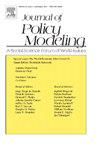美国驱逐政策对美国、加拿大和墨西哥经济的影响
IF 3.1
2区 经济学
Q1 ECONOMICS
引用次数: 0
摘要
北美(加拿大、美国、墨西哥)是一个高度互联的区域经济体(ICRE),拥有广泛的跨国生产价值链和强大的贸易、金融和劳动力市场联系。美国新驱逐政策的影响将在中短期内影响美国经济,由于外国出生的劳动力离开美国或退出劳动力市场,美国劳动力将减少近5%。利用全球可计算一般均衡(CGE)模拟模型进行的分析表明,这种冲击将导致美国的供给侧衰退,并使实际GDP减少4%。剩余无证劳工高参与的劳动力市场的工资将会增加,这将为未来增加的移民提供激励。本土出生工人的工资也会下降;研究表明,他们在其就业部门是对非本国劳动力的补充,而不是替代。美国的宏观冲击也会引发墨西哥和加拿大的宏观冲击,导致两国GDP下降。此外,外国出生的工人汇回原籍国的汇款也将急剧减少。对墨西哥来说,汇款减少将导致外汇损失造成的金融冲击,导致实际汇率大幅贬值和宏观总量的变化:GDP下降,进口减少,出口增加,最终总需求大幅下降。墨西哥的金融冲击将反馈到加拿大和美国,影响两国贸易和生产的部门构成。总而言之,美国消除外国出生劳动力的政策将对这三个国家产生影响,损害它们的经济,削弱北美的经济一体化。本文章由计算机程序翻译,如有差异,请以英文原文为准。
The impact of US deportation policies on the US, Canadian, and Mexican economies
North America (Canada, US, Mexico) is a highly inter-connected regional economy (ICRE) with extensive cross-country value chains in production and strong trade, financial, and labor market links. The impact of new US deportation policy would affect the US economy in the short to medium term by reducing the labor force by nearly five percent as foreign-born labor leaves the country or drops out of the labor market. Analysis with a global computable general equilibrium (CGE) simulation model indicates that the shock would cause a supply-side recession in the US and reduce real GDP by four percent. The wage in the labor markets with high participation of the remaining undocumented labor would increase, which would provide an incentive for increased future migration. There would also be a decline in the wage of native-born workers; studies indicate that they are complements not substitutes for non-native labor in their sectors of employment. The US macro shock would also induce macro shocks to both Mexico and Canada, yielding reductions in their GDP. In addition, there would be a dramatic decline in remittance flows from foreign-born workers to their countries of origin. For Mexico, the reduction in remittances would lead to a financial shock due to lost foreign exchange, resulting in a major depreciation of the real exchange rate and changes in macro aggregates: lower GDP, lower imports, increased exports, and much lower aggregate final demand. The financial shock in Mexico would feed back to Canada and the US, affecting the sectoral composition of trade and production in both countries. In sum, the impact of US policies to remove foreign-born labor would reverberate across all three countries, damaging their economies and weakening economic integration in North America.
求助全文
通过发布文献求助,成功后即可免费获取论文全文。
去求助
来源期刊

Journal of Policy Modeling
ECONOMICS-
CiteScore
6.20
自引率
11.40%
发文量
76
期刊介绍:
The Journal of Policy Modeling is published by Elsevier for the Society for Policy Modeling to provide a forum for analysis and debate concerning international policy issues. The journal addresses questions of critical import to the world community as a whole, and it focuses upon the economic, social, and political interdependencies between national and regional systems. This implies concern with international policies for the promotion of a better life for all human beings and, therefore, concentrates on improved methodological underpinnings for dealing with these problems.
 求助内容:
求助内容: 应助结果提醒方式:
应助结果提醒方式:


